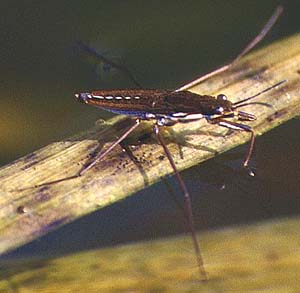
BUG OF THE MONTH: May 1994
Water Striders, family Gerridae
Copyright © 1994 by Louise Kulzer
This article originally appeared in Scarabogram, May 1994, New Series No. 169, pp. 3-4.
|
|
| Gerris lacustris © Markku Savela |
Who has failed to admire the elegant water strider, gliding effortlessly over the surface film of woodland pools? Idyllic, almost magical. However, the fact is that water striders are finely adapted predators not above cannibalism when pickings get slim. They walk on water not by magic but by virtue of a hydrophobic pad of hair fringing the end of the tarsi. The claws are positioned a bit further back rather than at the end of the tarsi so as not to break the surface tension. Awesome might be a more fitting modifier.
Water striders are true bugs (order Hemiptera) and as such, have piercing mouthparts. Some species have winged forms (front wings sclerotized for the basal half only), but wingless and brachypterous (short-winged) individuals are also common in most species. Winged individuals are purported to undertake dispersal flights on summer evenings or moonlit nights (Riley 1920b). Wingless or brachypterous individuals usually remain on the water surface of their birthplace.
During severe drought, however, when their pools dry up, they have been observed to lumber off overland in hopes of locating wetter pastures. Apparently these overland migrations are haphazard affairs, with chances of finding suitable habitat decreased significantly if over 14 yards from the parent pool (Riley 1920a).
Gerrids have the distinction of having marine representatives - mostly in the genera Hermatobates and Halobates. Hermatobates haddoni inhabits coral reefs, skating on tide pools at low tide (Herring, 1965). At high tide it withstands up to 10 feet of inundation by ocean water. What a bug!
At first glance, water striders appear to have only two pairs of legs. On closer inspection, the "missing" (first) pair, is shorter and held in front of the insect, typically resting on the surface film. This front pair of legs is used to detect ripples in the surface film from struggling insects, much as a spider detects vibrations in the web with its legs. The first legs also serve to grasp and handle the prey. Water striders are often gregarious, and groups of mixed species have been observed to "flock" together (Silvey 1931). Gregariousness is a somewhat curious habit for predators, but not unique to water striders by any means. Future musings are in order.
|
|
| Gerris marginatus (right) Rheumobates rileyi (left) |
Water striders go through five instars before they become adult. Some species exhibit "juvenile" locomotion prior to the third instar. They "hop" over the surface rather than glide smoothly as their elders do. Rheumobates rileyi, a rather tiny water strider from the Midwest, is known to have these "hopping" juveniles (Silvey 1931). I did notice a hopping water strider a few years ago in a pool along Newport Way at the base of Cougar Mountain. I thought it was so hilarious I got down on my belly to get a closer look. Sure as heck, this water strider unceremoniously braced its second pair of legs and pushed over them with the back pair: kind of like playing leapfrog with itself. I thought it was a species I'd never seen before, but it certainly could have been a juvenile (now don't you agree, bugs offer unlimited opportunities for discovery!)
Water striders have two basic body forms, ones with long, narrow abdomens and ones with short, broad abdomens (see above). In the west, the genus Gerris is the only representative of the long-abdomen type, but there are lots of species. Short abdomen western genera include Halobates and Metrobates. In addition, the families Veliidae and Mesoveliidae can closely resemble short abdomened Gerrids. Care is in order before jumping to hasty conclusions about bugs on the surface film.
I just have to mention one more kinky thing about water striders. Rheumobates rileyi has a copulatory position in which the antennae of the male and female intertwine. Really. Maybe idyllic is OK after all.
Thanks are due Rod Crawford who generously loaned me the out-of-print materials which contained many of these fascinating tidbits.
References
Herring, J.L. 1965. Hermatobates, a new generic record for the Atlantic Ocean, with description of a new species. Proceedings of the U.S. National Museum, 117(3510): 123-130.
Riley, C.F.C. 1920a. Some habitat responses of the large water strider, Gerris remigis Say. American Naturalist, 42: 394-414, 483-505.
_____. 1920b. Migratory responses of water striders during severe droughts. Bulletin of the Brooklyn Entomological Society, 15: 1-10.
Silvey, J.K.G. 1931. Observations on the life-history of Rheumatobates rileyi (Berg.) (Hemiptera - Gerridae). Papers of the Michigan Academy of Science, Art and Letters, 13: 433-447.
This page last updated 16 June, 2005